Ijraset Journal For Research in Applied Science and Engineering Technology
- Home / Ijraset
- On This Page
- Abstract
- Introduction
- Conclusion
- References
- Copyright
Analysis of Radon Mass Exhalation in Soil Samples from Fault Regions of Kolasib District Mizoram, India
Authors: Laldingngheta Ralte, Ramesh Chandra Tiwari, Rosangliana Chawngthu, Bijay Kumar Sahoo
DOI Link: https://doi.org/10.22214/ijraset.2022.39788
Certificate: View Certificate
Abstract
In order to identify the distribution of radon mass exhalation soil samples from fault regions of Kolasib District were obtained. These were measured and analysed using scintillation based smart RnDuo device. The soil samples were collected from three different points in each selected fault. The exhalation rates from different locations ranges from 2.3 mBq/kg/hr – 54.19 mBq/kg/hr with an average of 20.42 mBq/kg/hr. Gamma survey measurement was also carried out which ranges between 89 nSv/hr – 157 nSv/hr with an average of 117.13 nSv/hr. The correlation graph between mass exhalation and gamma survey was plotted and a very weak correlation was obtained.
Introduction
I. INTRODUCTION
The main source of radiation comes from cosmic rays, solar radiation and radioactive elements from the earth. The atmosphere prevents a majority of radiations from cosmic and solar radiations from reaching the earth but decay of radioisotopes like uranium, thoron, radium and radon. Radon is gas formed on the fourteenth step of sequence of radioactive decay series and is being continuously formed in the soil and released in air. This radon gas released in the air occupies 43% of radiation received by human beings and is usually the reason of lung cancer[1-2].
The movement of radon inside the soil is called emanation where radon is released into small air or water contained in pores between soil and rock particles and when it arrives at the soil surface it exhales into the atmosphere. The movement of radon is achieved by means of diffusion, advection and by means of gas transport[3]. The concentration of radon in soil is influenced by soil moisture content, barometric pressure variations, temperature and structure of soil. Radon becomes environmental hazards when it remains concentrated in enclosed places such as houses, caves and mines. Indoor radon and its influence on health has been studied by many researchers and the main contributor to these indoor concentration are radon from the soil and its exhalation[4-5]. Therefore radon and its exhalation from the soil are significant in obtaining data to be used in indoor concentration as well as for baseline data for further studies.
The purpose of this study is to obtain data for exhalation rates from soil samples collected from fault regions of Kolasib district, Mizoram, India. The fault regions are selected because faults are also responsible for movement of radon through rocks inside the earth[6]. This is the first investigation done regarding mass exhalation in soil samples on fault regions of Kolasib district. The results from this investigation will provide data for further studies in the future.
In this work, the radon exhalation from soil samples collected from various fault regions of Kolasib District, Mizoram are measured along with gamma survey of each region. The results are compared with the exhalation of radon in some parts of India.
II. MATERIALS AND METHODOLOGY
The study area is located at north-east of India on Kolasib district in the state of Mizoram which lies in the seismic zone V of seismic zonation map of India. The geographical sites where the soil samples were collected from the fault lines are as shown in Fig 1. Kolasib district is located on the north of Aizawl, which is the capital of the state Mizoram. It is a tropical region with moderate climate and the temperature varies from 11ºC to 24 ºC during the winter season and 18 ºC to 29 ºC during summer. The sampling area extends from N 23° 53' 29.57'' to N 24° 28' 16.1’’ latitude and E 092° 39'33.97'' to E 092° 47'41.09'' longitude.
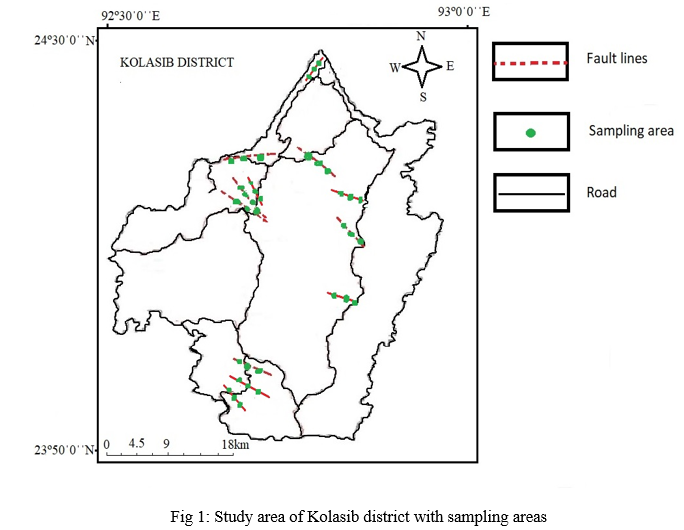
Soil samples were collected from 36 different locations within the study area as shown in Fig 1. The soil samples were collected in such a way that for each fault line on the area, three samples were collected by means of gardening tools. The soil is burrowed a few centimeters deep depending on the structure of soil and the top most soil is avoided when sampling the soil. The samples are then brought back to the lab where they are analysed.
The Radon content in soil was obtained by means of scintillation cell method using Smart RnDuo. It is a technologically advanced portable radon /thoron monitor, designed for multiple applications in radon and thoron studies. By diffusion process, sample gas is collected into a scintillation cell and passes through a progeny filter and thoron discriminator eliminating the progenies. The thoron discriminator does not allow the short lived thoron to pass thorough. The radon measurements in RnDuo are based on detection of alpha emitted from radon and its decay products formed inside a scintillation cell volume and are continuously counted by the PMT and the associated counting electronics.
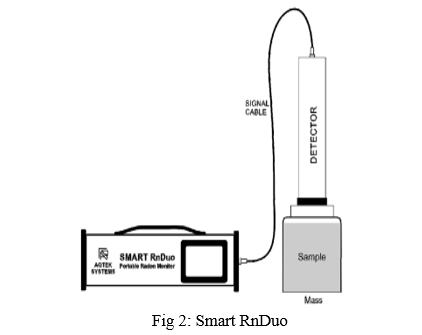
When measuring radon, the volume and mass are taken before placing them on the exhalation chamber. The sample is then placed in the chamber and fitted with the detector connected by signal cable to the main device. The samples are then measured for a cycle of 60 minutes for a minimum of period of 8 hours. Build up data of radon with elapsed time can be retrieved and least square fitting can be carried out using the equation:


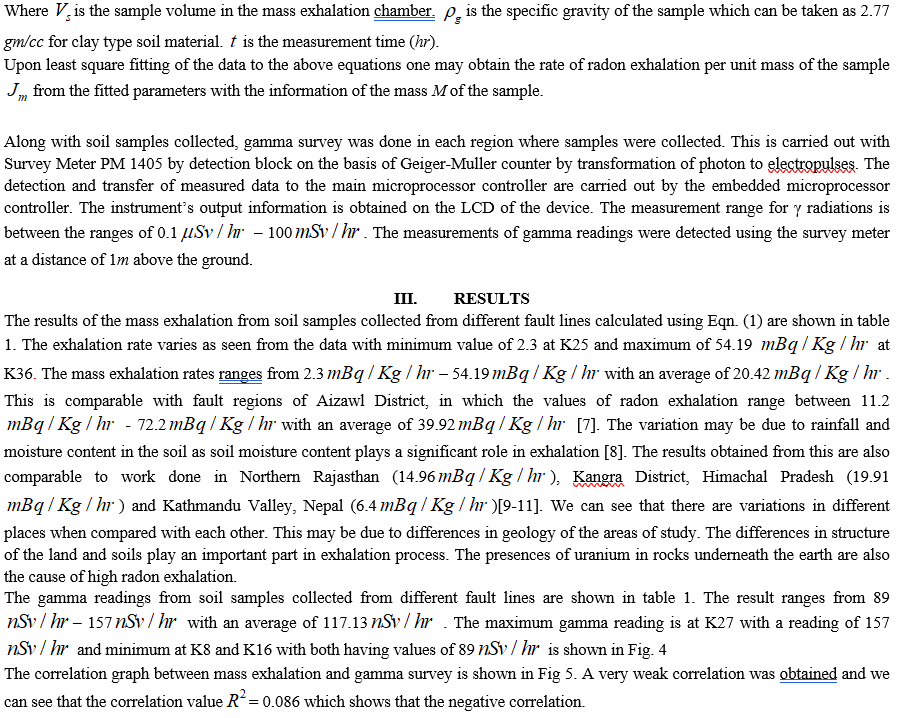
Table 1: Measurement of radon mass exhalation rate and gamma survey from fault regions of Kolasib district
|
Location code |
GPS Coordinate |
Gamma Survey meter readings (nSv/hr) |
Radon mass exhalation rate (mBq/kg/hr) |
Error Percentage (%)
|
|
K1 |
Elevation 23 m N 24° 20' 45.23'' E 092° 40'08.88'' |
106 |
8.2 |
15
|
|
K2 |
Elevation 36 m N 24° 20' 51.39'' E 092° 40'17.69'' |
101 |
11.9 |
15 |
|
K3 |
Elevation 44 m N 24° 20' 58.15'' E 092° 40'32.85'' |
107 |
24.6 |
15 |
|
K4 |
Elevation 260 m N 24° 15' 27.80'' E 092° 40'36.50'' |
141 |
35.5 |
15 |
|
K5 |
Elevation 351 m N 24° 15' 11.15'' E 092° 40'37.48'' |
127 |
25.4 |
11 |
|
K6 |
Elevation 431 m N 24° 14' 49.92'' E 092° 40'56.08'' |
119 |
35.9 |
16 |
|
K7 |
Elevation 385 m N 24° 14' 52.80'' E 092° 41'36.26'' |
127 |
45.0 |
15 |
|
K8 |
Elevation 410 m N 24° 14' 59.27'' E 092° 41'34.60'' |
89 |
12.8 |
13 |
|
K9 |
Elevation 403 m N 24° 14' 41.37'' E 092° 41'24.56'' |
119 |
10.0 |
15 |
|
K10 |
Elevation 474 m N 23° 53' 29.57'' E 092° 40'23.97'' |
98 |
11.0 |
15 |
|
K11 |
Elevation 468 m N 23° 53' 39.61'' E 092° 40'25.25'' |
135 |
7.6 |
15
|
|
K12 |
Elevation 447 m N 23° 54' 14.22'' E 092° 40'26.09'' |
110 |
5.6 |
16 |
|
K13 |
Elevation 186 m N 23° 55' 59.81'' E 092° 40'19.32'' |
132 |
27.7 |
13 |
|
K14 |
Elevation 138 m N 23° 56' 04.76'' E 092° 39'46.88'' |
108
|
28.4 |
15 |
|
K15 |
Elevation 152 m N 23° 56' 00.50'' E 092° 39'33.97'' |
102 |
6.7 |
15 |
|
K16 |
Elevation 271 m N 23° 57' 59.14'' E 092° 40'54.97'' |
89 |
28.8 |
10 |
|
K17 |
Elevation 313 m N 23° 57' 19.59'' E 092° 41'04.06'' |
109 |
35.7 |
16 |
|
K18 |
Elevation 311 m N 23° 57' 11.55'' E 092° 41'06.12'' |
118 |
32.7 |
16 |
|
K19 |
Elevation 48 m N 24° 20' 58.1'' E 092° 45' 32.0'' |
129 |
9.9 |
15 |
|
K20
|
Elevation 38 m N 24° 20' 57.5'' E 092° 45' 23.5'' |
130 |
11.5 |
15 |
|
K21
|
Elevation 37m N 24° 20' 59.0'' E 092° 45' 16.6'' |
105 |
6.5 |
15 |
|
K22
|
Elevation 49 m N 24° 28' 11.5'' E 092° 46' 54.9'' |
142 |
45.3 |
13 |
|
K23
|
Elevation 53 m N 24° 28' 16.1'' E 092° 46' 53.4'' |
130 |
45.7 |
15 |
|
K24
|
Elevation 58 m N 24° 28' 15.7'' E 092° 46' 56.6'' |
157 |
26.2 |
15 |
|
K25
|
Elevation 350 m N 24° 14' 56.4'' E 092° 41' 12.3'' |
120 |
2.3 |
15 |
|
K26
|
Elevation 360 m N 24° 14' 55.2'' E 092° 41' 12.6'' |
127 |
9.8 |
13 |
|
K27
|
Elevation 365 m N 24° 14' 52.3'' E 092° 41' 11.8'' |
145 |
21.6 |
14
|
|
K28 |
Elevation 679 m N 24° 14' 12.85'' E 092° 48' 26.37'' |
127 |
18.95 |
16 |
|
K29 |
Elevation 695 m N 24° 13' 55.04'' E 092° 48'24.42'' |
92 |
15.27 |
15 |
|
K30 |
Elevation 683 m N 24° 13' 44.86'' E 092° 48'17.95'' |
112 |
8.76 |
16 |
|
K31 |
Elevation 582 m N 24° 12' 06.28'' E 092° 48'30.34'' |
106 |
17.68 |
16 |
|
K32 |
Elevation 587 m N 24° 12' 08.93'' E 092° 48'34.25'' |
111 |
21.80 |
14 |
|
K33 |
Elevation 665 m N 24° 12' 23.88'' E 092° 48'04.52'' |
114 |
9.50 |
16 |
|
K34 |
Elevation 717 m N 24° 06' 18.61'' E 092° 48'40.71'' |
115 |
11.46 |
13 |
|
K35 |
Elevation 668 m N 24° 05' 41.82'' E 092° 48'15.32'' |
110 |
4.05 |
16 |
|
K36 |
Elevation 834 m N 24° 06' 09.95'' E 092° 47'41.09'' |
112 |
54.19 |
14 |
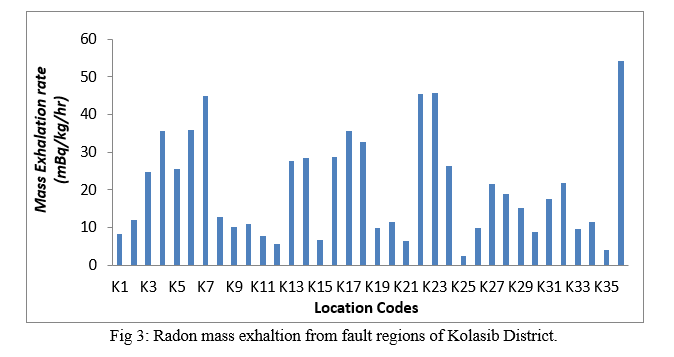
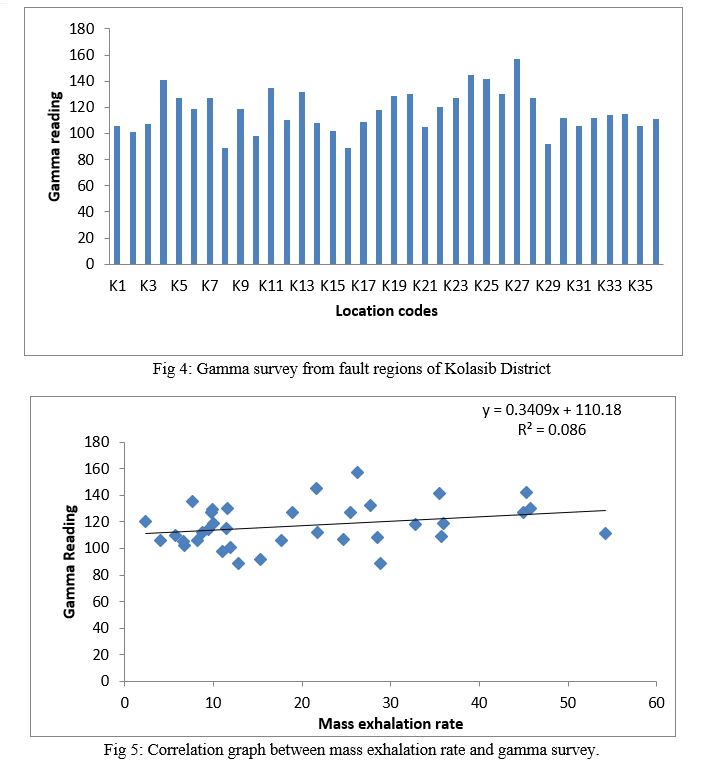
IV. ACKNOWLEDGEMENT
The authors are thankful to the Board of Research in Nuclear Sciences, Department of Atomic Energy sanction number 36(4)/14/67/2014-BRNS/36016, Government of India, for providing financial assistance through the Research Project.
Conclusion
The averages of mass exhalation from fault regions of Kolasib district were obtained and comparable to other regions. The average values were higher than other regions due to differences in geology of the areas of study and due to the proximity of the fault lines. Gamma readings obtained shows slight variations on different regions and the correlation between mass exhalation and gamma survey shows negative correlation.
References
[1] J.D. Appleton, J. C. H. Miles and D.K. Talbot. Dealing with radon emissions in respect of new development: evaluationof mapping and site investigation methods for targeting areas where new development may require radon protectivemeasures. Nottingham: British Geological Survey.(2010) [2] X.Lu., Loretta Y. Li and X.L. Zhang. An Environmental RiskAssessment of Radon in Lantian Karst Cave of Shaanxi, China.Water Air and Soil Pollution, (2009);198, 307–316. [3] T.f. YANG, C.Y. CHAU, C-H. CHEN,L.L. CHYI and J.H. JIANG. Exhalation of radon and its carrier gases in SW Taiwan. Radiat. Meas.,(2003); v.36, pp.425-429 [4] V. Duggal,R. Mehra, and A. Rani.An Investigation of factors influencing indoor radon concentrations in dwellings of Northern Rajasthan, India. Journal of the Geological Society of India. (2015);86(2), 173–180. [5] R. Sivakumar. A study on indoor radiation dose, radon, thoron and progenies concentrations in a hilly area. Environmental Earth Sciences.(2016);75(11), 1–13. [6] V.M. Choubey, K.K. Sharma and R.C. Ramola. Geology of radon occurrence around Jari in Parvati valley, Himachal Pradesh, India. J. Environ. Radioact.(1997);34(2):139-147. [7] Laldingngheta, Vanramlawma, Hmingchungnunga, L. Z. Chhangte, R.C.Tiwari, Rosangliana, B.Zoliana, B.K. Sahoo and T.K. Agarwal. Measurement of radon exhalation from soil samples in various fault regions of Aizawl district, Mizoram, India. Perspective and Trends in the Development of Science Education and Research (2018);198. [8] M. Faheema and Matiullah. Radon exhalation and its dependence on moisture content from samples of soil and building materials.Radiaiton Measurements(2008);43(8),1458-1462 [9] V. Duggal, R. Mehra and A. Rani .Study of Radium and Radon Exhalation Rate in Soil Samples from Areas of Northern Rajasthan. Journal of Geological Study of India.(2015);86(3),331-336 [10] D.K. Sharma, A.Kumar, M. Kumar and S. Singh. Study of uranium, radium and radon exhalation rate in soil samples from some areas of Kangra district, Himachal Pradesh, India using solid-state nuclear track detectors. Radiation Measurements.(2003);36(1-6),363-366 [11] P. Parajuli, D. Thapa and B. R. Shah. Study of Radon Exhalation Rate in Soil Samples of Kathmandu Valley Using Passive Detector LR115. Inter J ChemPhys Sci.(2015);4(4),30-9
Copyright
Copyright © 2022 Laldingngheta Ralte, Ramesh Chandra Tiwari, Rosangliana Chawngthu, Bijay Kumar Sahoo. This is an open access article distributed under the Creative Commons Attribution License, which permits unrestricted use, distribution, and reproduction in any medium, provided the original work is properly cited.

Download Paper
Paper Id : IJRASET39788
Publish Date : 2022-01-03
ISSN : 2321-9653
Publisher Name : IJRASET
DOI Link : Click Here
 Submit Paper Online
Submit Paper Online

